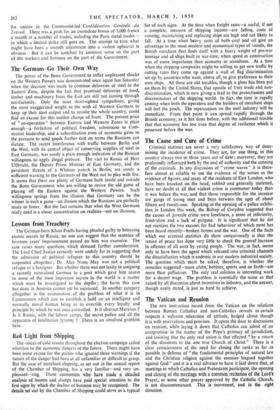Red Light from Shipping
The voices of cold reason throughout the election campaign called attention to the economic dangers of the future. There might have been some excuse for the parties who ignored these warnings if the nature of the danger had been at all unfamiliar or difficult to grasp. But the case of merchant shipping, as set out in the annual report of the Chamber of Shipping, has a very familiar—and very un- pleasant—ring. Those economists who have made a detailed analysis of booms and slumps have paid special attention to the first signs by which the decline of business may be recognised. The details set out by the Chamber of Shipping could serve as a typical list of such signs. At the time when freight rates—a useful, if not a complete, measure of shipping income—are falling, costs of running, maintaining and replacing ships are high and not likely to fall. At a time when heavy costs of both coal and oil give an advantage to the most modern and economical types of vessels, the British merchant fleet finds itself with a heavy weight of pre-war tonnage and of ships built in war-time, when speed in construction was of more importance than economy or soundness. At a time when the shipping companies might be willing to get new traffic by cutting rates they come up against a wall of flag discrimination set up by countries who want, above all, to give preference to their own ships. All these are old troubles, though a gloss has been put on them by the United States, that apostle of freer trade and non- discrimination, which is now giving a lead to the protectionists and discriminators of the shipping world. In fact, the time is rapidly coming when both the operators and the builders of merchant ships will feel the pinch. The repercussion on the steel industry will be immediate. From that point it can spread rapidly through the British economy, as it has done before, with the additional trouble that that economy has lost even that degree of resilience which it possessed before the war.


































 Previous page
Previous page